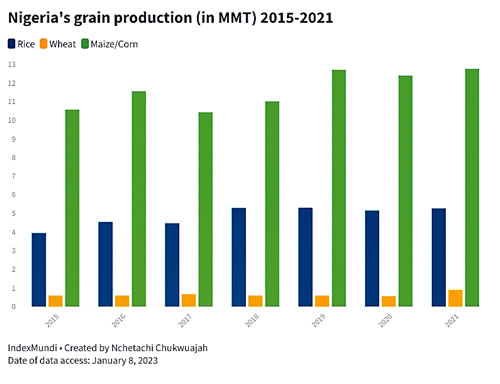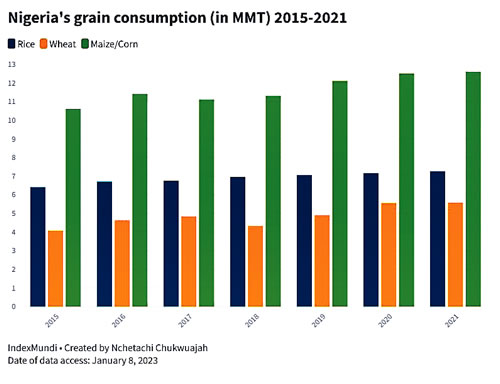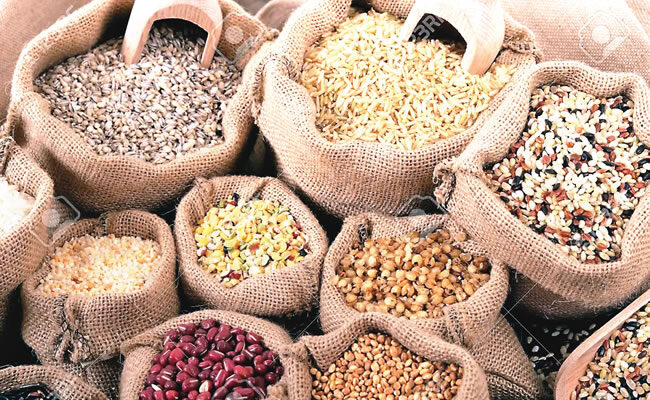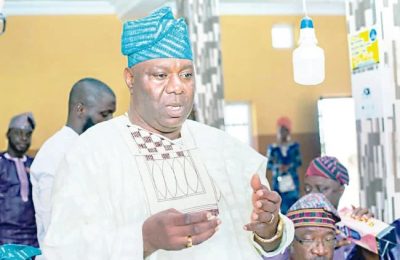
With the rising food prices in Nigeria, NCHETACHI CHUKWUAJAH, in this report, analyses the factors that pose challenges to the food sufficiency and security drive of Nigeria.

Global post-COVID economic contraction has persisted as nations struggle to adapt to new economic conditions.
In Nigeria, the situation is no different. It has impacted virtually every aspect of the economy with surging inflation, especially the food sufficiency and security drive of the Federal Government.
In August 2022, the country’s inflation rate reached a 17-year high of 20.23 percent. Since then, it has continued to rise, reaching 21.09 percent in October and 21.47 percent in November 2022.
Recall that a few months ago, bread bakers, under the aegis of Premium Bakers Association of Nigeria (PBAN), increased the price of bread by 20 percent after a four-day strike over increasing prices of baking materials.
The association, through its president, Emmanuel Onuorah, had noted that the materials for the baking business had more than doubled in price in the past few months.
The situation is not different in other sectors that depend on grains such as wheat, maize, rice, etc, for their businesses. The situation has been exacerbated by many factors, including the depletion of Nigeria’s foreign exchange reserve, the protracted Russia-Ukraine war that has cut off grain exports from both countries, the increasing prices of petroleum resources, and the recent flooding of many food-producing states in Nigeria, among others.
In the face of all these challenges, the Federal Government has consistently restated its commitment to ensuring food availability, sufficiency, and security. This it has done through various programmes, policies and even interventions by the Central Bank of Nigeria (CBN).
Recall that on January 18, 2022, President Muhammadu Buhari unveiled 13 pyramids of 115,000 bags of 100kg paddy rice produced by rice farmers under the aegis of the Rice Farmers Association of Nigeria (RIFAN) at the Federal Capital Territory, Abuja.
The well-attended event was organised to mark the association’s Rice Festival, the beginning of production for the 2021/2022 dry season and loan repayment to the CBN’s Anchor Borrowers’ Programme (ABP).
President Buhari, the governor of the CBN, Godwin Emefiele, and indeed all present at the rice pyramid unveiling ceremony opined that it was symbolic of the huge investment in the agriculture sector by the Buhari-led administration, especially through the ABP, which was launched in 2015, and the dividends thereof.
They noted that with such quantity of rice on display, Nigerians are guaranteed food security and sufficiency, and assured that the high cost of rice and other staple foods in the country would soon come down.
President Buhari had said, “The inauguration of these rice pyramids today is an indication that our country is making steady and assured progress towards self-sufficiency in food production, and it is my desired hope and expectation that other agricultural commodity associations that are yet to participate under the Anchor Borrowers’ Programme will emulate the Rice Farmers Association of Nigeria in supporting our administration’s drive for food self-sufficiency.”
Emefiele had said the bank, through the ABP, had invested N1 trillion to support the farmers in achieving the feat.
“As of the end of December 2021, we have financed 4,489,786 farmers who cultivated 5,300,411 hectares across 21 commodities through 23 Participating Financial Institutions in the 36 states of the federation and the FCT.
“Today, rice production in Nigeria has increased to over 7.5 million metric tonnes annually. Prior to the introduction of ABP, the average production in Nigeria between 1999 and 2015 was less than four metric tonnes annually,” he said.
From these statements, the critical question is if a ceremonial display of bags of rice is the parameter for measuring food sufficiency and security in a country of over 214 million people with a population that the World Bank says is growing at an average of 2.6 per cent annually?
Nigeria’s population, consumption and food security
In 1996, the Food and Agriculture Organization (FAO) said that for there to be food security in any country, all people at all times should have access to enough/sufficient food to meet their dietary needs, which makes for a healthy and productive life.
The FAO also predicted that the demand for food would double globally by 2050 as a result of population and economic growth. Additionally, it affirmed in 2009 and 2013 that population has a significant impact on food security.
This means that if appropriate measures are not taken to mitigate it, food availability, accessibility, and utilisation may be depleted while food demand and consumption would increase at the rate at which Nigeria’s population is growing.
Dr Nehemiah Danbaba, Assistant Director, National Cereals Research Institute (NCRI), Ibadan, said for developing countries such as Nigeria, cereals or grains play a huge role in determining food security and sufficiency as they make up 70 to 80 percent of food consumed.
Unfortunately, the country is not able to match its grain consumption needs with production, forcing it to import from other countries, such as India, Thailand, Pakistan, Vietnam, etc., to measure up.
For instance, KMPG, in its 2019 Rice Industry Review paper said, “Only about 57 percent of the 6.7 million metric tonnes of rice consumed in Nigeria annually is locally produced, leading to a supply deficit of about three million metric tonnes.
“With rapid growth in the country’s population, which is estimated to exceed 200 million by 2019, it is expected that the demand for rice will be sustained and increased in the foreseeable future.”
The situation is not different for other grains.
 Nigeria’s grains consumption vs production levels
Nigeria’s grains consumption vs production levels
In the case of rice, KMPG said that globally, Nigeria is the 11th largest consumer of rice and has the lowest annual consumption per capita of the top 11 consuming countries, with a value of 35 kg/year. It has one of the highest domestic market prices for a kilogram of rice for both locally produced and imported variants.
“High domestic prices for rice in Nigeria is mainly due to inflation, cost of importation (large excise tariffs have been imposed by the government in a bid to boost local production) and cost of production (for the locally produced variety),” KMPG stated.
With population growth and food demand, Nigeria has moved from consuming 4.1 million metric tonnes (MMT) of rice in 2007 to 6.9MMT in 2018, according to KMPG.
In terms of production, Nigeria is the highest producer of rice in Africa followed by Egypt and Madagascar, and 13th in the world. The country moved from producing 2.0MMT of rice in 2007 to almost 3.8MMT in 2018.
Commenting on the production-to-consumption shortfall, KMPG said, “In Nigeria, rice consumption far exceeds production with a yearly average production deficit of about 2.4 million tonnes recorded between 2007 and 2018.
“In order to meet the present deficit due to insufficient local production, Nigeria imports rice from several exporting countries to increase its total supply. In 2018, three million tonnes of rice was imported into Nigeria via its shipping ports as well as informal cross-border channels (importation through land borders is prohibited). Nigeria imports most of its rice from Thailand, India and the USA, incurring a bill of about $5 million daily.”
According to data from the indexMundi, Nigeria produced 10.562MMT of corn in 2015, 11.548MMT in 2016, 10.420MMT in 2017, 11.0MMT in 2018, 12.700MMT in 2019, 12.40MMT in 2020 and 12.745MMT in 2021. On the other hand, the US agency noted that Nigeria consumed 10.600 MMT of corn/maize in 2015, 11.400MMT in 2016, 11.100MMT in 2017, 11.300MMT in 2018, 12.100MMT in 2019, 12.500MMT in 2020 and 12.600MMT in 2021.
For wheat, Nigeria recorded 60,000MT production in 2015 and 2016, 67,000MT in 2017, 60,000MT in 2018 and 2019, 55,000MT in 2020 and 90,000MT in 2021. Domestic consumption of wheat for the same period was 4.070MMT in 2015,4.632MMT in 2016, 4.829MMT for 2017, 4.319 MMT for 2018, 4.900MMT for 2019, 5.550MMT for 2020 and 5.580MMT for 2021.
 Hydra-headed causes?
Hydra-headed causes?
Numerous factors have been suggested as the cause of the current food crisis and insecurity being experienced in Nigeria, in addition to the problem of population growth. Experts say that the lingering Russia-Ukraine war has had spillover effects on the global economy, as many countries that depend on them for grains, fertiliser and more have been badly affected.
Aliko Dangote, the chairman of the Dangote Group, forewarned of an approaching food crisis at the beginning of the Russia-Ukraine conflict in March of this year. He had advised the discontinuation of the export of maize as prices of grains and fertiliser would increase.
“There will be a shortage of wheat, maize and a lot of products because as we speak, Russia and Ukraine do almost 30 per cent of the world’s urea and 26 per cent of the world’s potash and even phosphate also, they are one of the largest in the world.
“There will be a scarcity of food generally, we would not be able to access fertilisers going forward, we may not see the effects now but in the next two-three months. Even the US will not be able to do the same tonnage they did last year because of this.
“Right now, you start seeing people exporting maize to earn foreign exchange which I think we need to stop so that we don’t create a shortage and we need to make sure we grow so that we don’t have a shortage.”
The increasing cost of importation as a result of customs charges by the Nigeria Customs Service (NCS) is another factor that has been identified to as the cause of the increasing costs of food in the country.
During its 2022 budget defence before the House of Representatives’ Committee on Excise and Customs, the NCS, through its Comptroller General, Hameed Ali, said it exceeded the N1.678 trillion revenue target by N563 billion to generate N2.241 trillion in 2021. The House Committee, headed by Leke Abejide, set the revenue target for the Service for 2022 at N3.01 trillion, representing an increase of N769 billion.
With this new task, the NCS would have to increase duties on goods imported into the country.
Another reason adduced for the increasing food crisis in Nigeria is the rising inflation rate. In its Consumer Price Index (CPI) for the month of August 2022, the National Bureau of Statistics (NBS) said inflation rate rose to a 17-year high of 20.52 percent compared to 19.64 per cent and 18.6 per cent recorded in June and July 2022, respectively.
The rate has maintained the upward trend, with a 21.09 per cent recorded in October and 21.47 per cent in November, 2022. The NBS had attributed the increase in food inflation to increases in prices of food products such as bread and cereals, yam and other tubers, meat, fish, oil, etc.
In an interview with Nigerian Tribune, Dr Nnaemeka Obiaraeri, an agro-economist, noted that a major cause of the food crisis being experienced in Nigeria is the under-utilisation of the nation’s resources.
Dr Obiaraeri said with Nigeria’s vast arable land, the country can be self-sufficient in food production, export and generate revenue.
“We have been paying lip service to growing the commodities that we can grow domestically. Nigeria today has 64 million hectares of arable farmland. Our domestic rice consumption is estimated to be seven to 7.5MMT per annum and currently we are not producing enough. Self-sufficiency in domestic rice production and demand would only be evident when the prices of rice in Nigeria goes down compared to what we have today.
“We can actually meet demand. If we are using the local FARO 54 variety of rice, we can produce about four tonnes of rice per hectare. Of course, rice can be cultivated twice a year in Nigeria through the right agricultural practices.
“Let’s say we use the FARO 54 variety, all we need to do is, out of the 64 million hectares of land that we have, if we dedicate one million hectares of land, cultivating twice in a year, using fully irrigated arrangements and good agricultural practices, employing one million youths—one youth per hectare of land or even two million youths, two per hectare—we can produce enough rice domestically. We can cultivate and harvest enough rice in Nigeria to be able to meet domestic demand.
“Also, if we decide to set up 1,551 pottage rice milling factories that can produce about 16 tonnes of rice per day, we will be able to cultivate, harvest and process enough rice in Nigeria for our domestic consumption and be able to export to the rest of West Africa that will employ nothing less than 1.5 to three million youths across Nigeria, sustainably,” he said.
Another factor that is at the top of the list is the challenge of insecurity in almost all parts of the country, especially in high food-producing areas. From farmer-herders clashes, to killing of farmers by bandits and setting farmlands ablaze, the challenge of insecurity rings.
On several occasions, different farmers’ associations have lamented the killing of their members by bandits, herdsmen or thieves.
There is also the impact of climate change, which has disrupted farming and most agricultural processes. Over the last couple of years, climatic change has led to delayed rainfall, drought, intense rainfall, flooding, and intense sunshine, among others. These alterations in the weather condition, as it was known, have left farmers with little yield as they grapple with its impact.
The African Development Bank (AfDB) had noted that Africa loses five to 15 percent of its per capita economic growth to the effects of climate change. The flooding witnessed in Nigeria in October 2022 was reported to have claimed 603 lives, displaced 1.3 million people, and destroyed 108,393 hectares of farmland in 34 out of the 36 states.
Dr Danbaba opines that issues around climate change such as its impact and mitigation should be included in extension services for farmers.
“Another step is to intensify extension services to give knowledge to farmers as to how to mitigate climatic changes, how to adopt good agronomic practices for production, how to reduce losses, and how to store their produce without infestation either by weevil or by diseases or by any kind of destructive vectors. “If these things are done, Nigeria will be able to get to the point of sustainable food security,” he said.
‘Post-harvest losses need to be mitigated, irrigation facilities, resilient crop varieties provided’
Dr Danbaba maintains that curbing the losses experienced at post-harvest level must be mitigated to shore up the quantity of available grains.
“We must invest hugely in post-harvest loss reduction,” he said, noting that “post-harvest loss reduction should be key, especially for grains.”
He explained further that, “minimising post-harvest loss is a very strong strategy that must be taken for us to be able to achieve self-sufficiency. At the post-harvest level, we are losing between 10 and 40 percent based on our recent study. If at the national level, we produce x amount of yield and we lose 10-40 per cent, the gap will not be filled in a short time but if we work on minimising the post-harvest loss to between five and seven maximum, as obtained in other developing world, that will give Nigeria a very fast way to achieve sufficiency.”
Dr Danbaba also called for investment in irrigation facilities as well as development of resilient crop varieties. “We must also start developing our irrigation facilities to a small kind of water-user facility where smallholder farmers can assess water and produce off-season crops that can sustain the gap between the rainy season and the dry season.
“We should start looking at crops that are resilient to the changing climate. We have seen drought where we didn’t think there would be drought before. We have seen floods where we don’t think floods could have appeared. We must have crops that are resilient to these changes and that can adapt to them; if not, we are going to have a shock. Where we think Nigeria has attained, we will go down to zero because of either drought, flood or something in-between,” he said.
Other factors are cases of emergency and disaster, poor infrastructural facilities needed for large scale agriculture, poor seed varieties, pest infestation, inadequate incentives for youths to embrace agriculture.
Ray of hope
In March 2022, a N2.5 billion-Dangote Fertiliser Plant located in Ibeju-Lekki, was inaugurat ed. The plant hopes to produce 3MMT of urea per annum to shore up Nigeria’s fertiliser deficit, create employment, encourage large scale agriculture, and conserve foreign exchange.
According to a 2020 report by the Africa Fertiliser and International Fertiliser Development Centre (IFDC), Nigeria produced 281,750 MT of urea in 2015, 695,000 MT in 2016, 1.4MMT in 2017, 1.59MMT in 2018 and 1.47MMT in 2019 and went from consuming 319,656 MT in 2015 to 730,151 MT in 2019.
At the commissioning of the plant, President Buhari had said that it held great promise for Nigeria’s agriculture sector as it would “reduce our dependence on the importation of fertiliser, create jobs on a massive scale, increase the inflow of foreign exchange, and accelerate economic growth.”
The president explained that “many Nigerians who practise subsistence farming because of the unavailability of necessary input can now take up agriculture as a business. We expect the rise of a new breed of agropreneurs who will add value to farming and make the nation self-sufficient in food production.”
Godwin Emefiele, governor, CBN, had also said, “Today, Nigeria is self-sufficient in the production of urea and we are also the leading producer of urea in Africa. There is no doubt that improving access to fertiliser will contribute to significant improvements in the productivity of our local farmers. But, probably more importantly, it will enhance our nation’s drive to improve food security and ensure we consume what we produce in Nigeria.”
Technology, mechanisation and industrialisation to the rescue
In a publication, PricewaterhouseCoopers (PwC) noted that the production gap in rice farming in Nigeria can be bridged through the mechanisation and integration of technology in the rice farming process. PwC maintains that this would ultimately boost rice farming and increase Nigeria’s rice production.
“Low income, limited access to affordable financing, and a lack of technical skills have limited the adoption of mechanisation across the rice value chain. We estimate that increasing the rate in Nigeria from 0.3hp/ha to 0.8hp/ha in the next five years can double rice production to 7.2 million tonnes. To achieve this, we estimate that Nigeria will need to at least triple its current stock of machinery over the same period. In addition to raising production adequately, increasing mechanisation has the capacity to raise yield, increase labour productivity, reduce post-harvest losses, increase income generated by farmers, and deepen import substitution.
“Nigeria’s mechanisation gap provides numerous opportunities for investment across the agricultural value chain. To attract the required investment, the government needs to create an enabling environment that ensures mechanisation is profitable. In terms of priorities, the government should concentrate on: addressing challenges around land tenure and ownership, providing rural infrastructure and extension services, and ensuring incentives are transparent and accessible to all investors.”
ALSO READ FROM NIGERIAN TRIBUNE








